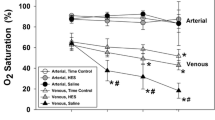Summary
The partial pressures of oxygen (PO2), carbon dioxide (PCO2), and hydrogen ion concentrations (pH) were determined in the blood of young adult mice sacrificed either by cardiac arrest,” or by “asphyxiation”. Cardiac arrest was produced by electric shock, and asphyxiation by sudden occlusion of the trachea. A single blood sample, drawn from the left ventricle three minutes after death, was analyzed. Death due to asphyxiation resulted in a significantly lower PO2 when compared to death due to cardiac arrest. There was no significant difference in PCO2 or pH.
The possible implications on the study of sudden unexplained infant deaths (SID syndrome) in humans is discussed.
Similar content being viewed by others
References
Frissel, Wilhelm R. (1968). Acid-Base Chemistry in Medicine.The Macmillian Company, Inc., New York. pp. 53–54.
Kaaki, A.E. (1969). The effect of asphyxia upon the lactate, pyruvate and bicarbonate concentrations of brain tissue and cisternal CSF, and upen the tissue concentrations of phosphocreatins and adenine nucleotides in anesthetized rats.Acta Physiol. Sound. 78, 447.
Michel, C.C. (1968). The buffering behaviour of blood during hypoxaemia and respiratory exchange: Theory.Respiration Physiology,4, 283.
Mithoefer, J.C. (1967). A method of distinguishing death due to cardiac arrest from asphyxia.Lancet,2, 981.
Suwa, Kunio, (1947). Arterial—alveolar CO2 gradient after cardiac resuscitation in the dog.Anesthesiology,30, 37.
Swann, H.G. and Brucer, Marshall. (1947). The cardiorespiratory and biochemica events during rapid anoxic death.Texan Biol. 7 592.
Author information
Authors and Affiliations
Additional information
This investigation was supported by P.H.S. Training Grant Number (1 A04 AH 0003-01) from Department of Health Education and Welfare.
This work was a partial fulfilment of the thesis requirements of James Aldrich at San Fernando Valley State College.
Rights and permissions
About this article
Cite this article
Aldrich, J.O. Agonal physiology and blood gas tensions. Indian J Pediatr 39, 259–263 (1972). https://doi.org/10.1007/BF02756212
Received:
Issue Date:
DOI: https://doi.org/10.1007/BF02756212




